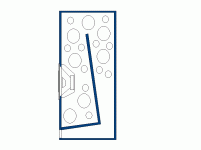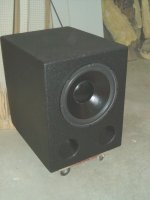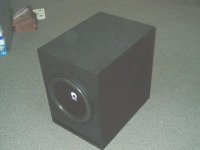long time reader, first time poster.
I'm getting a box design for my HT subwoofer, and I need a hand.
I'm a car audio person, and usually only deal with frequencies down to about 33 or 34 hertz. However this enclosure will be tuned to 17.7 hertz.
Some information about it..
amplfier will be a Dayton HPSA1000 (1000 watts RMS at 4 ohms)
subwoofer will be a RE Audio SX18 (dual 2 ohm rated for 1000 watts RMS)
enclosure: 60" tall, 24" wide, 24" deep.
17.14 cubic feet total
8.74 cubic feet after displacements
tuned to 17.7 hertz
Now, I have already figured out the bracing. They will be "squares" that have 2.5" rails (not sure what to call them) and go around the box, exept for the one that is next to the woofer (see pictures). I'm debating whether or not to double up all 6 sides of the enclosure to make it more rigid.
suggestions?
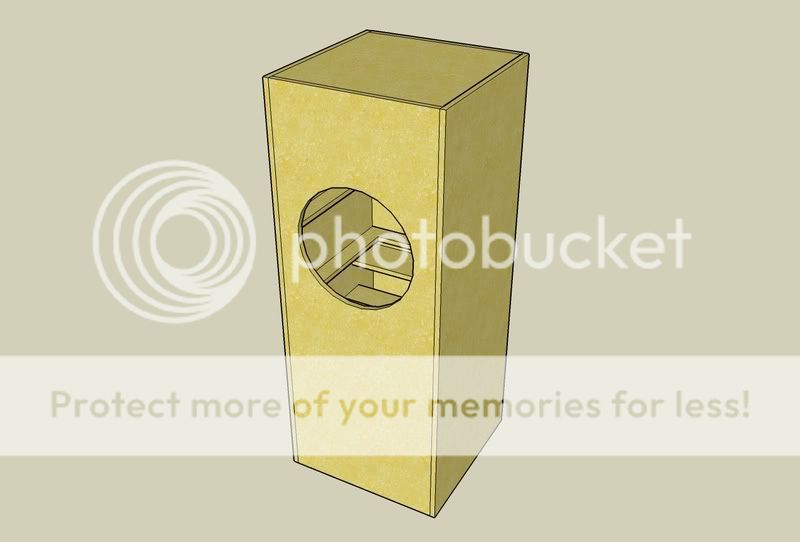
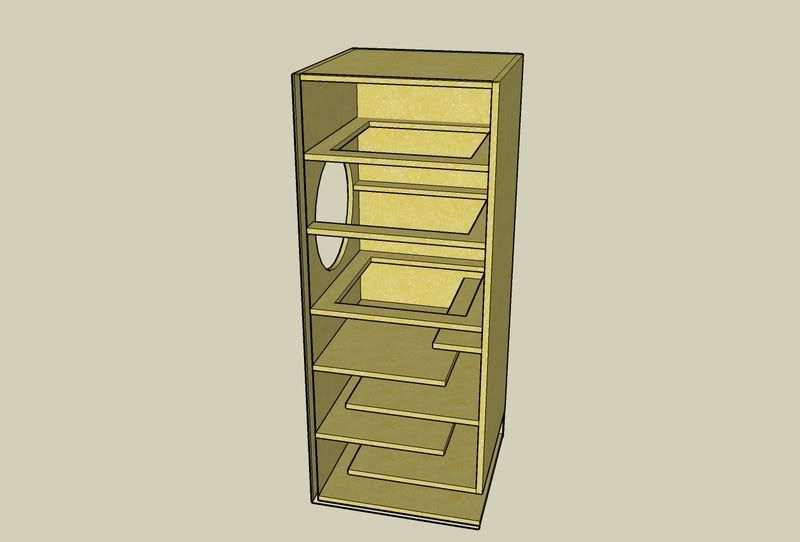
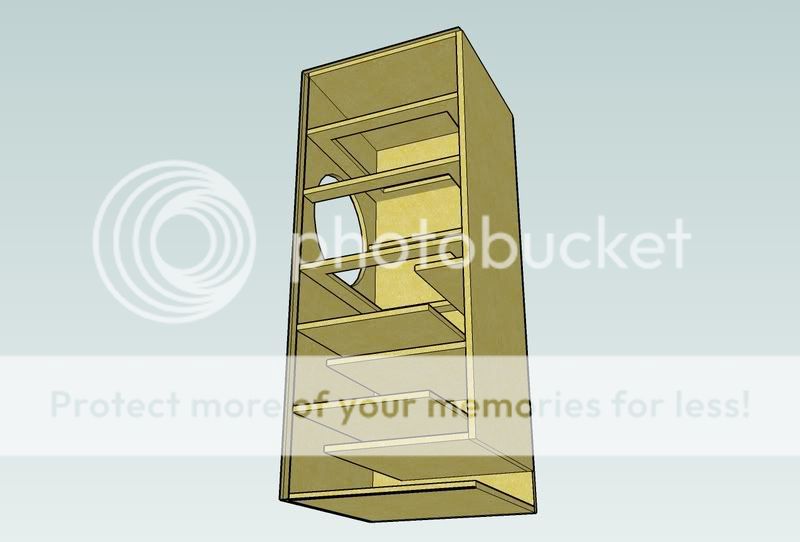
I'm getting a box design for my HT subwoofer, and I need a hand.
I'm a car audio person, and usually only deal with frequencies down to about 33 or 34 hertz. However this enclosure will be tuned to 17.7 hertz.
Some information about it..
amplfier will be a Dayton HPSA1000 (1000 watts RMS at 4 ohms)
subwoofer will be a RE Audio SX18 (dual 2 ohm rated for 1000 watts RMS)
enclosure: 60" tall, 24" wide, 24" deep.
17.14 cubic feet total
8.74 cubic feet after displacements
tuned to 17.7 hertz
Now, I have already figured out the bracing. They will be "squares" that have 2.5" rails (not sure what to call them) and go around the box, exept for the one that is next to the woofer (see pictures). I'm debating whether or not to double up all 6 sides of the enclosure to make it more rigid.
suggestions?



Have you modeled that box in MJK? With the size of the port this is going to behave more like a daline (ie transmission line with a pre-chamber) than a bass reflex so any modeling you have done in a standard issue modeller is going to be off.
Also, the bracing would likely be more effective if run the other way (but i guess that fits in with the folded port/TLine. I'd run the line vertically with a lot less folds.
Are you going to build it out of void free plywood?
dave
Also, the bracing would likely be more effective if run the other way (but i guess that fits in with the folded port/TLine. I'd run the line vertically with a lot less folds.
Are you going to build it out of void free plywood?
dave
Box would more than likely be plenty strong with your bracing.
I have had strange responses (not ending up like the model said) when I put a bunch of folds in a vent like that, I have done it several times. I have switched to running the vent on the bottom, up the back and along the top if need be, so only 2 folds max, most of the time only one. That has always seemed to work more reliably for me...
If you have the time and patience, roundover all the internal brace edges with a router, and any parts of the port(s) you can on the inside...
I have built many H/T subwoofers using SE and SX 15s and 18s.... I love them for that application... They are bulletproof...
Last one used an SX15 and that same amp... Go figure... LOL!
I have had strange responses (not ending up like the model said) when I put a bunch of folds in a vent like that, I have done it several times. I have switched to running the vent on the bottom, up the back and along the top if need be, so only 2 folds max, most of the time only one. That has always seemed to work more reliably for me...
If you have the time and patience, roundover all the internal brace edges with a router, and any parts of the port(s) you can on the inside...
I have built many H/T subwoofers using SE and SX 15s and 18s.... I love them for that application... They are bulletproof...
Last one used an SX15 and that same amp... Go figure... LOL!
I use bassbox pro to do the basic design... it works nice when it comes down to accounting for brace/driver displacement. Then I just draw it with Google SketchUp. I'll probably give this enclosure a try to see if it works. I have the same idea designed except with 2 folds going down, then up. The only problem is that it would be hard to brace.
The first thing I notice is the port and as others said, it's not going to function like a traditional port according to the model. You should always try to avoid any angles of 90 degrees or more if possible. A pair of 45 degree angles or even 45degree piece in the corner greatly improves things. In this case you have four 180degree changes in direction. You are expecting air to go one way, stop, then go the other way 4 times. All the changes in direction will cause a serious decrease in vent velocity, which means you lose output. Air also compresses easily, especially when asked to change direction 180 degrees. This will cause you to lose even more output. While you have a lot of vent area you'll end up with an effective area moving maybe 1/4 of air that you are expecting. That means you've lost a lot of output.
I'm assuming the vent is something like 6" x 22.5" cross section? That is probably more than you need for this kind of tuning. Although if you did that, you could open at the front on the bottom, come to the back then go straight up, and again go forward to the front. You can get about 100" that way. Put a 45 degree piece in the top and bottom corners, round the inside corners of the port there too. That essentially leaves you with 2 rounded 90 degree corners instead of 4 180degree changes in direction. You'll be capable of much more output.
John
I'm assuming the vent is something like 6" x 22.5" cross section? That is probably more than you need for this kind of tuning. Although if you did that, you could open at the front on the bottom, come to the back then go straight up, and again go forward to the front. You can get about 100" that way. Put a 45 degree piece in the top and bottom corners, round the inside corners of the port there too. That essentially leaves you with 2 rounded 90 degree corners instead of 4 180degree changes in direction. You'll be capable of much more output.
John
alright, so if I do that, the could I get away with the same type of bracing to the port, probably about 5 of them, and instead of bracing the rear, top, and bottom of the cabinet, just double the pieces up?
wasted911 said:enclosure: 60" tall, 24" wide, 24" deep.
17.14 cubic feet total
8.74 cubic feet after displacements
tuned to 17.7 hertz
Hi,
If you can live with a box that big, you might as well make it a TL. TLs are much more tolerant of design errors than bass reflex.
Here's how I did it before.
There is a full brace down the middle (that which has all the holes). This will give you amazing bass.
Attachments
You could also consider using passive radiators.
BTW, nice project, I hope everything goes well. You'll have incredible low bass with that.
BTW, nice project, I hope everything goes well. You'll have incredible low bass with that.
Well I've been looking at doing a TL, but I havnt the slightest clue on how to do one. I think I'll stick with the bass reflex.
Then again, I am looking for an enclosure to give me the most out of my woofer. I'd like to explore all boundries as I compete in DB drag (car audio).
Then again, I am looking for an enclosure to give me the most out of my woofer. I'd like to explore all boundries as I compete in DB drag (car audio).
wasted911 said:Then again, I am looking for an enclosure to give me the most out of my woofer.
that would be a tapped horn 🙂
I'd be willing to bet you would get the best results building your first H/T box as a bass-reflex, like you intended from the start.
I cant find anything about a tapped horm, other than a fellow has a patent on a design.
I'll go with the bass reflex for now, and if I dont like it, it'll be changed.
I'll go with the bass reflex for now, and if I dont like it, it'll be changed.
95Honda said:I'd be willing to bet you would get the best results building your first H/T box as a bass-reflex, like you intended from the start.
A base reflex like he intended is fine... but what he designed is not a bass reflex, it is a transmission line with a pre-chamber.
dave
can't find anything about a tapped horn
http://www.diyaudio.com/forums/showthread.php?s=&threadid=97674&highlight=
planet10 said:
A base reflex like he intended is fine... but what he designed is not a bass reflex, it is a transmission line with a pre-chamber.
dave
Exactly. Note when I said "intended"......... 🙂
I think he will be very happy with a proper bass reflex, with a proper port.
95Honda said:I'd be willing to bet you would get the best results building your first H/T box as a bass-reflex, like you intended from the start.
building a th isnt more difficult than building a br. just something different. instead of finding good numbers for volume, port size and length, you look for good numbers for throat, mouth, length and driver position. everything else is just woodwork.
ok, so I am going to stick with a bass reflex. Now I need your guys' help. I'm pretty much stuck. Can anyone design me, or put me on the right track for an enclosure?
my maximum measurements are:
8 feet to the ceiling (it'd be nice to keep it under)
30" wide
36" deep
here's a bit of the floor plan

I want it to go low. preferably 15 hertz. Any ideas?
my maximum measurements are:
8 feet to the ceiling (it'd be nice to keep it under)
30" wide
36" deep
here's a bit of the floor plan

I want it to go low. preferably 15 hertz. Any ideas?
I like the looks of this.. But I have no idea how to go about designing one.
http://www.diyaudio.com/forums/attachment.php?s=&postid=1152673&stamp=1173337480
http://www.diyaudio.com/forums/attachment.php?s=&postid=1152673&stamp=1173337480
I really don't think you need much help, you obviously understand how to get volume, port length, etc. And your drawings look very good. Just re-design your box using some of the input you have recieved.
You may also not need to bend the ports either, depending on your box volume and shape. Here is a picture of a box I built for an Adire Malstrom about 5 or 6 years ago. It was very large, Maybe 13-14ft3 and had a pair of 6" I.D. PVC pipes for vents. They only went along the bottom of the cabinet and ended up about 8" from the back. Also, 2 6" I.D. ports have plenty of area for the Malstrom or an SX 18. Tuning was right around 18Hz, IIRC..
You may also not need to bend the ports either, depending on your box volume and shape. Here is a picture of a box I built for an Adire Malstrom about 5 or 6 years ago. It was very large, Maybe 13-14ft3 and had a pair of 6" I.D. PVC pipes for vents. They only went along the bottom of the cabinet and ended up about 8" from the back. Also, 2 6" I.D. ports have plenty of area for the Malstrom or an SX 18. Tuning was right around 18Hz, IIRC..
Attachments
Here is a picture of an SE15 for a set-up almost identical to what you want to do. There is a Dayton 1000 watt plate amp on the back of the thing also. The vent and cabinet are smaller than what you would use, but proportionaly, similar. The vent went along the bottom and about half way up the back for a tune right around 20Hz.
Attachments
- Status
- Not open for further replies.
- Home
- Loudspeakers
- Subwoofers
- How strong does the box need to be?
